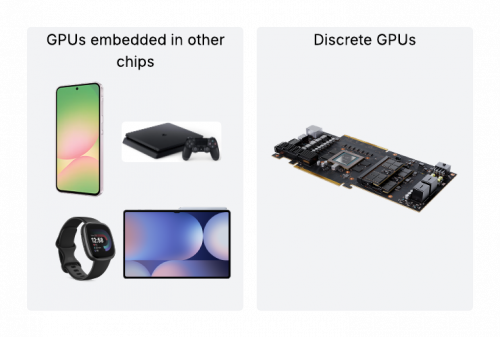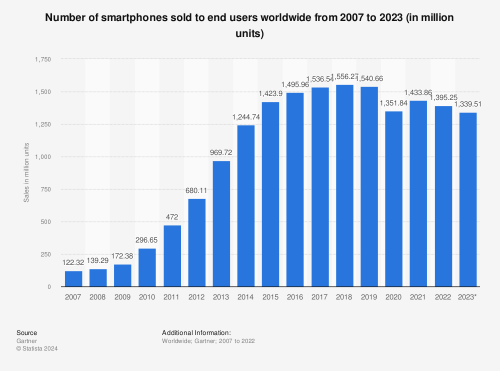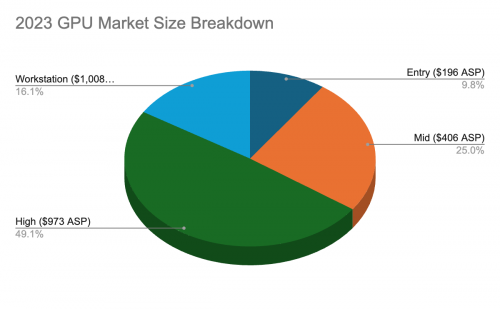Overview of the GPU Market
GPU Market Analysis
As a GPU builder, we collect, review, and analyze a significant amount of data to better the market. Some of our data comes from trusted analysts like Jon Peddie Research, and some comes from direct conversations with suppliers, buyers, and more.
TL;DR:
- Billions of GPUs are shipped each year
- >3 billion active gamers
- Up to 50% of film production is spent on rendering
- >$1B could be saved with faster rendering
- Complex parts and systems are simulated before being built
- Productivity across various industries is increasingly limited by compute power
- More vendors = lower prices and grows the overall market size
Jon Peddie Research is the leading respected analyst firm tracking the GPU market very closely. GPUs are sold in the following form factors:

GPUs are embedded into chips that have additional functionality (like CPUs, network interfaces, DPUs, and more). These are called SoCs (system on chips). This is usually done to reduce complexity, cost, power, and space. The tradeoff is limited performance and upgradeability. We typically see integrated GPUs in smaller form factors like watches, glasses, smartphones, tablets, laptops, consoles, cars, TVs, fridges, and more. Users do not pay to buy these GPUs; they are included in the price of the SoC or device.
The other form factor, discrete GPUs, is where vendors produce add-in-boards (AIBs) or custom cards that are installed by users or manufacturers into desktops, workstations, servers, and laptops.

Global GPU shipments have exceeded 200 million units since 2003, and GPUs have always outsold CPUs (meaning there are, on average, more than 1 GPU per PC).
In addition, over 1.1 billion smartphones are shipped every year, each with an integrated GPU inside.

The chart below shows the breakdown of the GPU market by segment, showing that 2/3 of the market is high-end and workstation GPUs:

Industry Market Analysis
Rendering
Rendering Market Background
Multiple industries (commercial, residential, industrial, architecture, and construction; filmmaking; game development; product engineering and design) rely on high-quality and fast rendering. The algorithm used to generate high-quality renders is called Path Tracing. The math behind path tracing has been around since the 16th century (source). It wasn’t until the late 1970s that path tracing made its way into computer graphics, thanks to the work of Turner Whitted and various other graphics pioneers.
To learn more about the history of rendering: History of Rendering: Rasterization, Ray Tracing, Path Tracing – Bolt Graphics
Now, path tracing is used to generate high-quality renders whenever access to powerful compute hardware is not an issue. Path tracing is also not optimally implemented in existing hardware and software solutions, so users that want real-time path tracing need to modify the algorithm and introduce shortcuts that don’t significantly impact the visual output, but do reduce the computational effort.
However, these users desire full path tracing in real-time, which is the market for Bolt’s path tracing optimized GPU.
Cinema
Visual effects (or VFX) are computer-generated or manipulated imagery blended with live-action footage for the purpose of enhancing reality onscreen. The sky’s the limit when you add effects to your project, and if you have a vision that can’t come to fruition without them, investing in the tools to produce digital effects can help you make it big in the industry. Think of the velociraptors in “Jurassic Park” or the Na’vi species in “Avatar.” (Source)
From Mission: Impossible II (2000) to Dune: Part Two (2024), every film topping the box office since 2000 has utilized visual effects that were generated on a render farm. Visual effects have been used in a variety of ways to almost transparently improve the realism or scale of a film or television show. We wrote a blog post in 2023 with some examples of visual effects usage in films you or your friends may have seen.
Studios moved towards visual effects to enable sets that weren’t feasible and reduce the costs of production through set extensions (virtual parts of a film set that extend the physical set), green screens, virtual production walls, in camera VFX, and more:
Scenes with large armies in combat use set extensions to reduce the number of extras required: VFX Team Talks ‘Mulan’ and How to Create Digital Extras Amid Covid-19 Era
Scenes with virtual city shots that are set back in time:
Scenes with characters that are animals or have superpowers:
Of course, animated films are even more reliant on visual effects, being hand-animated or with the assistance of motion capture.
As viewers consume content that continues to be driven by visual effects, the quality expectations from films have found their way into television shows, and even short form and casual content that has viewership numbers that rival premium cable shows:
Cocomelon, a nursery rhyme YouTube channel is completely animated and has 176 million subscribers and 183 billion views
Neo, a independent YouTube channel with educational short documentaries heavily uses animations and has 2 million subscribers and 275 million views
The B1M, a YouTube channel with videos on interesting construction projects, has 3.2 million subscribers and 604 million views
However, there is a big downside to using visual effects to enhance a project. Creating and rendering film-quality visual effects is expensive and time consuming. There are various estimates on the % of total budget spent on visual effects (including both human resource and computing power costs), ranging from 30% to over 70%. Films like Frozen, The Lion King, Dune, Avatar, and the Avengers franchise sit closer to the 70% mark while films like Dunkirk and The Dark Knight are closer to 30%.
Why It Takes Pixar 3 Years to Render a Movie
Avatar 2’s reported budget of between $300 and $400 million (before marketing costs) is where blockbuster films have been trending. The production team went over 500 iterations of visual effects shots, and the total time to render across all iterations (including the final renders) was over 3 years.
It’s great to see films like this pushing the boundaries of film production, but only a few very large studios (Disney/Lucasfilm/Pixar, Universal, Sony, Warner Bros) can replicate this budget and box office success. Visual effects quality that doesn’t meet customers’ visual expectations drives down box office, critic, and viewer reviews. Driving down the cost of visual effects directly enables more competitiveness for indie and individual filmmakers to enter the market where their whole film budget might equal the rendering budget of a larger studio.
Almost the entire visual effects market relies on Intel or Amd server CPUs to perform rendering. A render of a single frame can take 4-8 hours on many CPU servers (the scene assets, including geometry and materials, can quickly cross the terabyte mark). A 2 hour film at 30 frames per second can have upwards of 200,000 frames to render in total. This is 1.6 million rendering hours, and if not further parallelized, is 183 years of rendering. On a distributed render farm with 10,000 servers, this can take a couple of months. The cost of these servers upfront is upwards of $200 million, and around $10 million in cloud rental fees over those 2 months. This is for one iteration – any changes to the scene necessitate a re-render. As mentioned earlier, the Avatar team went through over 500 iterations.
GPUs are not used in film rendering as they are not faster than modern server CPUs. Servers with GPUs are also extremely expensive and hard to obtain. Specifically, Amd Epyc 128/192 core CPUs are faster at path tracing and support more memory than any Nvidia or Amd GPU. GPUs are especially poor at scaling, a key requirement in the visual effects industry.
AEC
The architecture, engineering, and construction industries also have significant demand for path tracing capabilities. Architecture firms that pitch their futuristic buildings used to rely on time consuming hand drawings. They still incorporate these into the early stages of design, but hand rendering an entire set of visuals is not practical:
Now, they design the building inside a CAD (computer aided design) tool, where they can apply materials, fill landscapes, and select a sky to make the building look realistic. This is all to help their clients understand and buy into the design. The firms also benefit because they have designed a complex building on a computer, and used the same model to show the client the design, significantly reducing labor cost and time to complete the project.
Many of us are used to seeing renderings of commercial buildings as this has become the standard. We asked various interior designers and architects how much time they spend waiting on renders to come back, and heard anywhere from 30-50%. As they are still billing their clients for the time they spend waiting, slow hardware actually has a huge impact on the economics of the industry.
According to the 2017 US Census, $2.47 billion alone is spent on interior design services payroll (source). Taking a conservative estimate of 25% of time spent waiting for renders, around $600 million could be saved or optimized by reducing rendering time.
On the engineering and product design side, almost every product “photo” today is actually a rendering. Similar to the architecture and construction markets, showing high-quality photorealistic renders of your product before it’s made can shift-left revenue and marketing impact. Famous watchmakers, shoe companies, and consumer electronics companies all rely on path tracing to generate marketing materials. Of course, they also use path tracing in their development process to get an early, accurate look at their design before it’s finalized.
Games
Games Market Background
Computer gaming is one of the largest markets in the world – across all ages, genders, and income levels. In the United States, 51.6% of the population is gaming:
39 million (11.70% of the US population) are super gamers, where their primary entertainment source is gaming
79 million (23.70% of the US population) are avid gamers, where gaming is one of several equivalent entertainment options
54 million (16.20% of the US population) are casual gamers
In addition, India has 601.6 million gamers (42% of population), Brazil has 154 million gamers (71.5% of population), and South Africa has 40 million gamers (66.3% of population). Globally, there are around 3.3 billion daily gamers.
In the US, many of the 39 million super gamers spend huge amounts to ensure they have the fastest, most up to date gaming system. Certain fast-paced games demand extremely high frame rates, and the monitors that drive 4K at over 120 fps typically cost over $1,000. The current fastest GPU on the market costs around $2,000 on the open market today. The total cost of the computer and peripherals can quickly exceed $20,000.
Looking at Jon Peddie Research’s numbers on the breakdown of PC’s that are optimized for casual games vs. mid- and high-end gaming, it’s clear that, over the past 10 years, every year around 20 million mid- and high-end gaming PCs were sold, while an immense 175-250 million casual gaming PCs were sold:
This 20 million mid- and high-end gaming PC segment is the perfect target market for Bolt’s initial entry, as they are:
Not price sensitive
New technology early adopters
Everyone else spends a lot less on gaming hardware – consoles typically retail between $300 and $500 (sold at a loss by Sony and Microsoft), and the average gaming PC GPU costs around $400.
Gaming is almost equally popular across age groups, with 56% of all gamers under 39 and 43% over 40. Gamers under 18 were not measured, although they likely represent a large percentage.
Gaming has achieved immense scale globally:
3.3 billion daily gamers
$190 billion in game sales in 2023
$41 billion in gaming GPU sales in 2023 (>90% Nvidia market share)
Gaming has a lot of the same issues as the Film & Television industry. Games are expensive to produce and optimize. Various game studios (indie, small, and large) have told us they spent 50% of their time and budget optimizing a game to be performant on the average GPU.
It is very common to replace actual computation of things like shadows and reflections with approximations that look similar to increase performance. These optimizations take time to invent, and developers can attend conferences like GDC to learn about new optimizations that studios developed and implemented inside specific games to get around poor GPU performance:
Realistic Real-Time Sky Dome Rendering in Gran Turismo 7: Pre-render all of the sky variants because it’s not fast enough in real-time on the PS5 target
Optimizing the Graphics Pipeline with Compute: “With further advancement in the current console cycle, new tricks are being learned to squeeze the maximum performance out of the hardware.”
If the studio has access to a higher performance ceiling, they can simply enable these features that require significant optimization and spend their time and money in other areas.
There are 3 key distribution channels for GPUs:
Integrated inside mass market consumer products (smartphones, tablets, laptops, prebuilt desktops): volume exceeds 500 million devices sold per year (very low margin)
Off the shelf GPU add-in cards: volume exceeds 60 million cards sold per year (low margin)
Into the cloud: volume is less than 1 million cards sold per year (higher margin)
HPC
HPC Market Background
The largest enterprises across the world are reliant on supercomputers to design and simulate almost everything over the past few decades. Everything on the list below was designed and engineered on computers before ever entering production:
(The companies listed below are not affiliated with Bolt Graphics)
- Materials (new and optimized plastics, cloths, metals, silicon, quantum, chemicals)
- BASF, Dow, Ineos, LG Chem, Nippon, Tata Steel, Hyundai Steel, Applied Materials, ASML, Lam Research, Tokyo Electron, DuPont
- Energy (oil, natural gas, photovoltaic, nuclear fusion/fission, steam, hydrogen, electric motors)
- Aramco, Exxon Mobil, Chevron, ConocoPhilips, Schneider, Reliance Industries, Cummins, BYD, Koch
- Communications (cellular, radio, copper, optical)
- Ericsson, Nokia, Motorola, Amphenol, Molex, Cisco
- Transport (cars, trucks, boats, airplanes, submarines, drones)
- Hyundai, Toyota, GM, RTX Corp (Raytheon), Northrop Grumman, Lockheed Martin, Boeing, BAE, Goodyear
- Sensors (CMOS, radar, lidar, sonar)
- Sony, STMicro, Onsemi, Canon, Panasonic, SK Hynix, Samsung, Teledyne, Thales
- Products & parts (semiconductors, actuators, PCBs, consumer electronics)
- TSMC, Micron, Samsung, GlobalFoundries, Intel, Amkor, ASE, Apple, Foxconn, Jabil, BYD
- Fluids (weather prediction, water, smoke, fire, gasses, clouds, hurricanes, tornadoes)
- USA NOAA, USA NSF, USA NSF, USA DoE, IBM, UK Met Office
- Biochemistry (vaccines, viruses, bacterias, food)
- Pfizer, Merck, Novo Nordisk, Gilead, Johnson & Johnson, Moderna, Roche, Eli Lilly, and many more
- Buildings, construction & civil (commercial, residential, industrial, cities, tractors)
- Gensler, Perkins&Will, Bosch, 3M, Caterpillar, Volvo, Komatsu, Hitachi, John Deere
- Missiles & weapons
- Lasers & optics
- Spaceships
Everything produced in this century has been at least partially simulated, and already moving quickly to full simulations. Simulations allow designers to eliminate all risk from building something, whether new or optimized. Imagine an EV startup wanting to optimize both the engineering and design of the EV, as well as simulating the manufacturing process before beginning construction on either the parts or the manufacturing facility. The cost and effort required to model and test the EV over many design iterations is cost-prohibitive, driving the startup to use computers to simulate.
Companies need On-Premise HPC – And For More Than AI, Too (May 2024)
HPC has widespread applications in secretive government agencies (maintaining warfare and technological superiority), in enterprise (maintaining product superiority), and in civil (maximizing usability and safety while reducing maintenance). These entities have understood that simulations reduce risk and increase outcomes in any complex project. It is not possible to avoid simulations when reliably producing any type of part or product at scale.
In fact, the Department of Defense has mandated simulation and model-based engineering as a crucial part of their contractors workflow. Companies like Boeing, Raytheon, and BAE Systems are now required to build simulation models on supercomputers in order to receive government funding and approval.
In the end, everyone is looking to simulate inside a physics sandbox. The sandbox ideally obeys the known laws of physics, providing a digital twin of the Earth. This sandbox is also ideally tunable, to enable simulations of other planets and theoretical environments. This is not technologically feasible today, so users have adopted specific tools that can simulate parts of the sandbox.
This has led to an explosion in the number of tools that are utilizing hundreds of large CPU and GPU supercomputers (costing >$500 million to install). The importance of just simulating semiconductors pushed Synopsys to buy the software simulation market leader, Ansys for $35 billion. Ansys does not produce any simulation-optimized hardware, rather just a suite of software tools that enables simulations on parts of the sandbox. This means that they are stuck trying to find low-ROI optimizations to increase performance. Their offerings include:
Ansys Fluent: fluid simulation software
Ansys Lumerical: photonic simulation software
Ansys Zemax: optical design software
Ansys Thermal Desktop
Ansys Motor-CAD
Ansys Sherlock: electronics reliability prediction software
The formal size of the HPC market is approximately $50 billion (accounting for the full server cost, not including software), and GPUs make up approximately $16 billion of that (Hyperion Research, slide 19).
The HPC industry is not directly addressed by any optimized technology. Modern GPUs lean towards less precise computations to increase performance at the expense of accuracy, whereas in HPC more precise computations are needed to keep the compounding error of the total simulation down. CPUs are still heavily used for many of the same reasons in Film & Television – CPUs have access to enough memory to run large scale simulations, and GPUs are power-hungry and expensive.
Unlike Film & Television and Gaming, HPC is currently not a consumer market and therefore is isolated from the cyclical nature of those industries. During the Covid-19 pandemic, supercomputer installs and use increased to enable governments and enterprises to perform more molecular dynamics simulations of possible vaccines.
Governments and research and defense agencies play a very large, but sometimes hidden role in pushing the capabilities of HPC simulations. By our count, the US DoD offers over 2.3 million CPU cores for use across 100+ agencies. We estimate the cost to build these clusters to be well over $600 million. Many of these clusters also contain hundreds of GPUs like Nvidia’s T4, A40, V100, A100, L40, L40S, H100, and Amd’s MI250X. It is interesting to note the GPUs are mostly used inside visualization nodes – they are not intended to run HPC simulations.


Darwesh Singh
Founder, CEO, & CTO
Darwesh Singh is the Founder, CEO, & CTO of Bolt Graphics. He spent over a decade designing large data centers for enterprise customers.